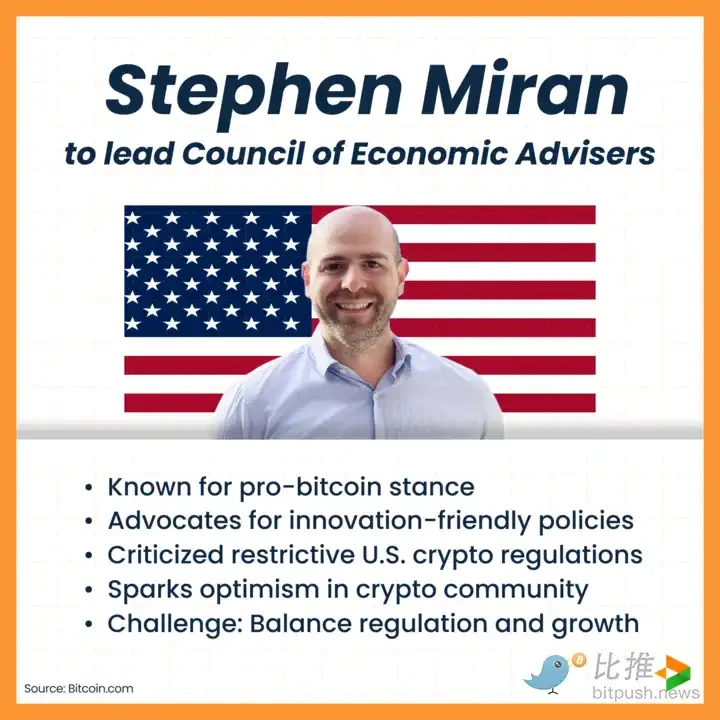Original Source: BitpushNews
On Thursday local time, as Wall Street was about to close, US President Trump announced on Truth Social that he would appoint Stephen Miran, chairman of the White House Council of Economic Advisers (CEA), as a member of the Federal Reserve Board to replace Adriana Kugler, who recently left office. His term is tentatively set to end on January 31, 2026.
According to Politico, the White House was not yet ready to announce the successor to the current Federal Reserve Chairman Powell. Milan's move was both a "window filling" and a "political signal."

Will this brief "Fed audition" become an unexpected boost for the crypto industry? And at a time when expectations of a Fed rate cut are intertwined with a weakening dollar, what does Trump's appointment of Milan mean?
Who is Stephen Miran? From Harvard to the White House, a crypto "friend"
Stephen Miran holds an economics degree from Harvard University, and his career spans investment and policy. Prior to joining the Trump administration, he was an investment partner at Amherst Peak Advisors and a senior strategist at Hudson Bay. Notably, Hudson Bay was deeply involved in debt trading following the bankruptcy of FTX, a cryptocurrency exchange that collapsed in late 2022. Its founder, Sam Bankman-Fried, was sentenced to 25 years in prison in November 2023 on seven counts, including wire fraud.
After joining the Trump campaign in 2023, Miran quickly rose to prominence, becoming Chairman of the White House Council of Economic Advisers (CEA) in March 2025. As a typical conservative economist, he firmly supports Trump's tariff policy and has repeatedly publicly advocated for "lowering interest rates" and "reassessing the strong dollar policy."
Miran has demonstrated a rare openness in the cryptocurrency space. In December 2024, Stephen Miran, then Chairman of the White House Council of Economic Advisers (CEA), was invited to appear on the renowned financial podcast "Forward Guidance," where he spoke with host Joseph Wang (former New York Fed trader known as Fed Guy). In the second half of the show, Miran discussed the problems posed by the chaotic regulation of cryptocurrency, stating bluntly:
“Maybe we should really simplify a lot of regulations to allow innovative industries like crypto to really take off.”

At the time, US crypto regulation was mired in chaos, with the SEC and CFTC locked in a dispute over token classification and the Coinbase vs. Binance case still unresolved. Milan's remarks were viewed by many industry insiders as "the first friendly signal from the White House." As CEA chairman, his views, while lacking legislative power, served as a guiding light for policy trends and regulatory discussions.

It’s worth noting that Miran isn’t blindly supporting the crypto industry. He’s opposed to the current reality of regulatory fragmentation, repeated approvals, and legal ambiguity, rather than regulation itself. He pointed out on the show:
The current dispute between the SEC and the CFTC over the nature of crypto assets (securities vs. commodities) has seriously impacted the compliance operations of innovative companies.
The White House should push for a more coordinated regulatory framework “to give entrepreneurs a clear roadmap to compliance.”
Regulation that is truly beneficial to innovation is not “no regulation” but “clear rules and clear responsibilities.”
This view, unlike traditional crypto maximalists, is closer to the path that institutional compliance crypto supporters – such as Coinbase CEO Brian Armstrong – have long advocated.
According to Coindesk, Milan also privately participated in discussions on the ambiguity between the SEC and the CFTC in the regulatory classification of tokens.
If Milan continues to publicly express his support for the rationalization of crypto regulation during his term at the Fed, even if it does not have a direct impact on policy making, it may become an important catalyst for market sentiment and even accumulate the voice of a "potential candidate for the board of directors" after 2026.
Federal Reserve Policy: The Entry of Rate Cut Advocates
“He just showed up to warm the seat,” said Mark Spindel, author of “Federal Reserve Independence.” “After a few meetings, he left.”
Indeed, from a timing perspective, Milan's participation in at most three Federal Open Market Committee (FOMC) meetings—in September, October, and December—will have a very limited structural impact on the full-year interest rate path.
But this doesn't mean Milan's voice is meaningless. As the interest rate war heats up in the second half of 2025, a single vote on the Governing Council could be enough to keep markets on edge.
At the monetary policy level, Milan can be described as a typical Trump-style economist: he supports "Made in America", questions the strong dollar strategy, and advocates interest rate cuts to stimulate growth.
Between 2023 and 2024, he repeatedly wrote and spoke publicly, arguing that the Federal Reserve's continued high interest rate policy was "extremely detrimental to U.S. manufacturing and exports," and calling for "a more proactive monetary policy aligned with industrial policy." He was also one of the few senior CEA officials to publicly state that "an overly strong dollar is detrimental to national interests."
This resonates with Trump's persistent criticism of Powell. Trump has repeatedly complained publicly, "Powell messed everything up, and high interest rates are making the United States uncompetitive." Milan has endorsed this view from an academic perspective, reinforcing the White House's stance that interest rates should be subordinated to growth targets.
While Milan is unlikely to alter the Fed's interest rate path in the short term, if he promotes the message within the Fed that "inflation is under control and the focus should be on employment and investment," it will undoubtedly provide the market with new policy options. Especially with high US Treasury yields and a weakening US dollar index, the return of expectations for rate cuts is becoming a key focus in the capital market.
Since the beginning of this year, the US dollar's safe-haven properties have faced unprecedented challenges. According to FactSet data, the US dollar index (DXY) fell by over 10% in the first half of 2025, marking its weakest first-half performance since 1973. The US dollar, which traditionally strengthens during periods of financial market volatility, is now rising alongside long-term US Treasury yields, exhibiting an unusual characteristic unique to emerging markets.

Some analysts suggest that Milan's challenge to the "strong dollar consensus" is forming the "embryo of a new consensus." In a paper, he questioned, "Is a strong dollar truly in the national interest? Should a more flexible exchange rate mechanism be considered for export-oriented manufacturing?" Such views are gradually gaining ground within the Trump administration.
How should the crypto market view Milan’s entry?
For the crypto industry, Miran’s temporary rise to the top could mean:
- Warmer policy tone: His stance reinforces the White House’s interest in crypto and could also lead to clearer regulatory integration.
- Sentiment towards risky assets is heating up: If he pushes for interest rate cuts or guides expectations of easing, risky assets such as BTC and ETH will directly benefit.
- The trend of the US dollar affects stablecoins and cross-border payment paths: a weak dollar strategy will increase the attractiveness of crypto assets in international payments.
While Milan isn't a legislator and can't single-handedly change the Fed's course, his views are already shaping the macroeconomic sentiment framework for the second half of 2025. This academic-turned-policymaker's true potential may extend far beyond these five months.
References:
· MarketWatch: Trump taps Miran for Fed seat
· Politico: Trump picks economic adviser Miran for Fed post
· Forward Guidance Podcast (2024.12)
FactSet, ICE Dollar Index
- 核心观点:特朗普任命加密友好人士米兰为美联储理事。
- 关键要素:
- 米兰主张简化加密监管框架。
- 支持降息与弱美元政策。
- 短期影响有限但或提振市场情绪。
- 市场影响:加密监管趋缓,风险资产或受益。
- 时效性标注:中期影响。



